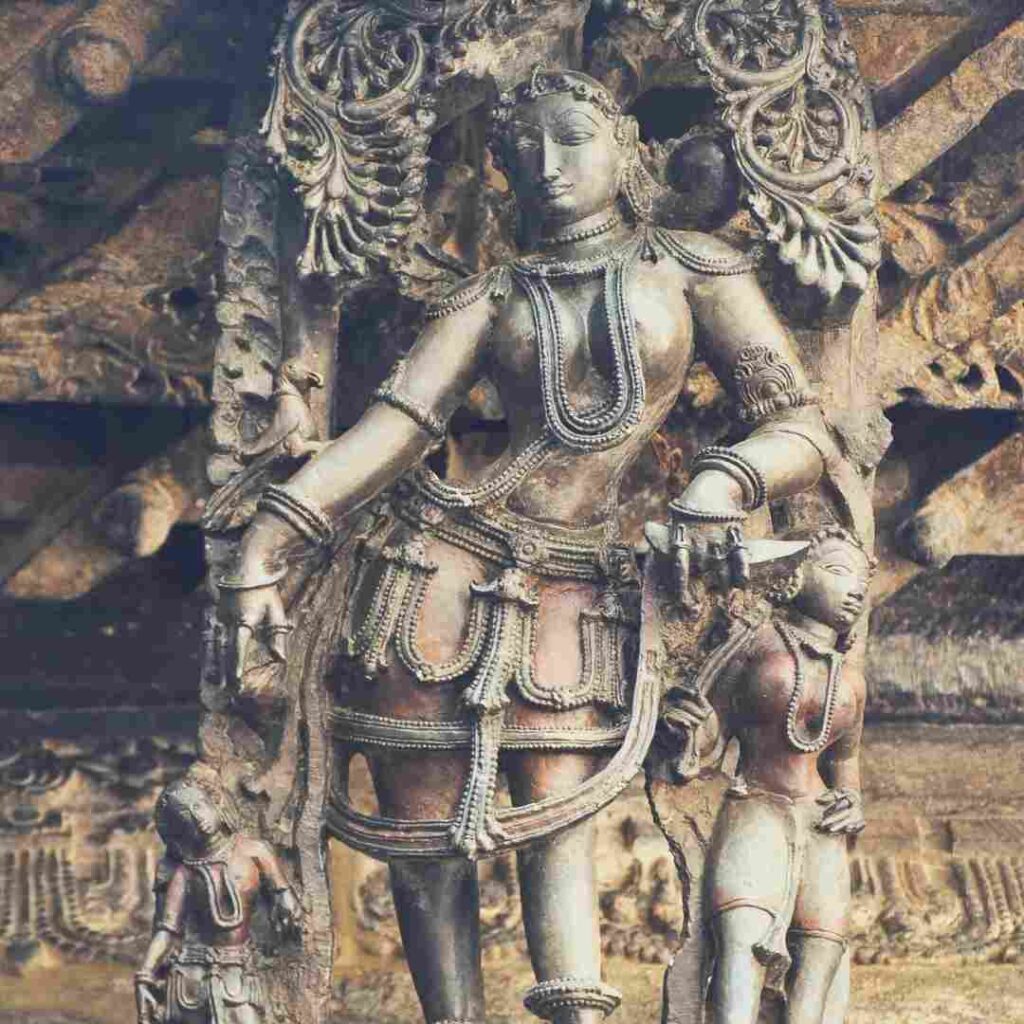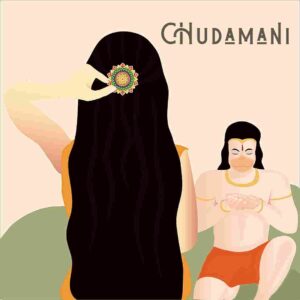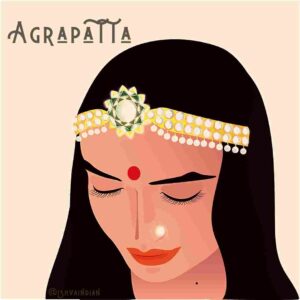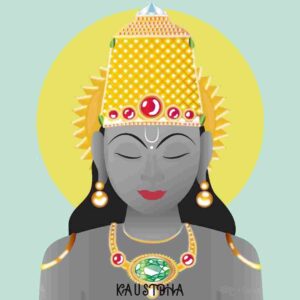Indian Jewellery: Ten iconic ornaments from classical India – Part One

Indian jewellery is as old as Indian civilisation itself. From the ruins of beaded jewels found in the Indus Valley, to the sculptures at Bharhut, Sanchi, Amaravati and the paintings at Ajanta, a wide range of jewellery has been worn by man and woman, by king and commoner. The temples of South India, Bengal, Odisha and Central India present a veritable cornucopia of the jeweller’s art.
In this series, we showcase a curated set of ten classical Indian jewelled ornaments in the #theartofadornment. It’s time to dazzle!
The Chudamani

Chudamani literally translates to hair jewel (chuda-hair, mani-jewel). This stunner is one of the most famous head ornaments with references tracing back to the epics – Ramayana and Mahabharata.
Chudamani is a lotus-shaped ornament, the petals of which are made of precious stones or plain gold, usually worn at the centre of the knot or worn behind the hair where the parting ends. It usually represents the status of a married woman.
In Sundara Kanda (5th part) of the Ramayana where Anjaneya reaches Lanka to find Sita, she gives her Chudamani to Anjaneya and narrates the incident where Rama presents the Chudamani to Sita, back in Ayodhya. It is said that sage Valmiki describes Sita’s Chudamani as a precious jewel sprung from the great ocean itself.
Another infamous reference traces back to Mahabharata where Draupadi is said to have taken an oath not to decorate her hair with her Chudamani until Dusshasana and Duryodhana are killed. Some historical mentions also trace back to literary pieces by Kalidasa such as Raghuvamsa and Meghadutta. Nagarjunakonda sculptures as well as those from Amaravati and Goli are represented with Chudamani as one of their Mastaka shobhana.
Is Chudamani part of your jewellery box? Make it so!
The Agrapatta

Agrapatta literally translates to ‘forehead band’.
An integral part of hair-dressing, Agrapatta is a common ornament for both men and women – traditionally made of a thin metal decorated with rows of beads, pearls, gems or flowers. However, as a detached ornament, it is restricted only to women. More elaborated agrapattas were generally used only by the royal women and it is strictly restricted to the royal women.
Agrapattas are also adorned by yakshas, devatas and deities. Some of the most detailed historical references of agrapattas are from Nagarjunakonda where many women sculptures are shown wearing a pendant hanging from the agrapatta, some elaborated and embellished with precious gems, and one even embellished with big beads and gems used by a river goddess!
Jaṭāmukuṭa

When the hair becomes the jewel!
Jaṭāmukuṭa translates to hair head jewel (jata-hair, mukuta – head jewel). The hair is dressed in such a way that it resembles a crown and usually bejewelled with beads. But there’s more to it!
According to the detailed description given in the Uttara Kamikagama, “The Jaṭāmukuṭa is described below: five jaṭās or braids of matted hair are taken and tied into a knot three inches in height by coiling them into one or three loops, the remaining braids being bound and taken through to be left hanging on both sides.” This is usually practiced or followed by people who take up asceticism. Many references in Hinduism, Jainism and Buddhism show the mentions of Jatamukuta.
Lord Shiva is famous for a Jaṭāmukuṭa on his head, signifying his asceticism. Lord Brahma is another deity who adorns the Jaṭāmukuṭa on his head, along with other jewels. Among the female deities, goddess Manonmani is said to adorn her hair with Jaṭāmukuṭa. It was considered as a go-to hair dressing for the sages / rishis and munis, who performed strict penance for years, according to Natyashastra.
There are references from Ramayana and Mahabharata, where Rama, Lakshmana and Sita, Pandavas and Draupadi adorned their hair in jaṭāmukuta while in Vanavasa. Jaṭāmukuṭa is also quite popular in Buddhist and Jain sculptures, where Gautama Buddha and Mahavira Jain tied their hair in Jaṭāmukuṭa. We need to give up the idea that jewellery is a mark of luxury or wealth, and the Jaṭāmukuṭa is a splendid case in point. Don’t you think?
Makarika

Makarika translates to crocodile jewel – a specific type of forehead jewel in the shape of a crocodile or a fish. This jewel is quite popular along with the chudamani which is also worn by women on the parting of the hair at the back end. Makarikas are also considered to be as elaborated as Chudamanis and these specific elaborated ones are usually adorned by women of royal status.
Some of the historical references trace back to Satavahan period, where women are said to use makarikas as hair ornaments. There are also literary mentions in Banabhatta’s Harshacharitra where there is a specific mention of a chudamanimakarika, which refers to a mythical fish-crocodile hair decoration.
The famous Nagarjunakonda sculptures near Andhra Pradesh also depict royal women using elaborated chudamanis and makarikas on their head. Another reference comes from Bharata Natyashashtra, that Shunga women had an elaborated hair dressing and they used makarikas to decorate their hair buns.
Kundala

Karna Shobana translates to ear dressing and this includes ornaments/jewellery used to decorate and embellish the ear lobes. This one here is the Kundala – a circular metal ring, preferably gold/silver worn through holes bored in ear lobes.
Kundalas in ancient times came in many shapes and sizes, but five of the well-known types are – patrakundala (patra – leaf shaped), makarakundala (makara – crocodile), sarpakundala (sarpa – snake), sankhapatrakundala (sankhaptra – conch leaf) and ratnakundala (ratna – gem studded). Kanchanakundalas are said to be made of pure gold and it is said to be worn by deities.
Some of the literary references for kundala include the Mahabharata where Karna is said to have been born with a natural armour (kavacha) and gold indestructible earrings (karna kundalas) through Suryadeva. Makarakundalas are worn by Lord Vishnu and Goddess Chandi. Beautifully illustrated here is a traditional form of Ardhanaareshvara that depicts the Kundala, where one half Purusha (Shiva) is adorned with Sarpakundala and the Prakriti (Parvati) is adorned with a Ratnakundala.
Know your Kundala!
Kaustubha

Kantha Shobhana, or Neck Adornment!
Kaustubha Mani – a chest jewel adorned by Lord Vishnu – deep blue in colour like a blue lotus with a radiance of the sun. It emerged as one of the fourteen treasures during Samudra Manthana, when Devas and Asuras churned the ocean of milk through Mandara parvata and Vasuki sarpa.
Many references to Kaustubha Mani were found in Agni purana, Bhagavata Purana, Ramayana and Mahabharata. It is dorned by Lord Vishnu as only Vishnu can handle the sheer brilliance and magnificence of the gem. Since Vishnu wears this jewel, one of his 1000 names include Kausthubhadhaari (one who wears Kausthubha gem). Lord Krishna also carries Kausthubha gem, being a complete avatar of Vishnu.
In Vedanta, the total consciousness which is termed as hiranyagarbha, represents the consciousness of all the living beings and is said to reside in a pure, subtle and unstained form in Kausthubha jewel. How profound is that!
Take me to Part Two
